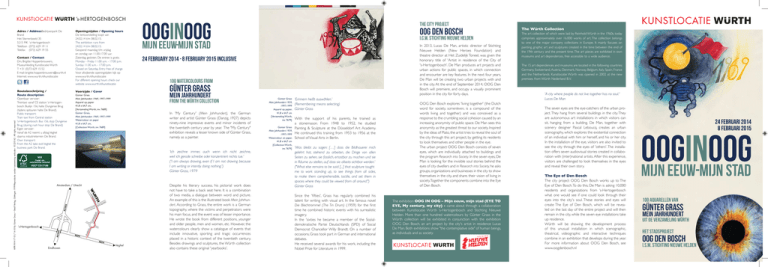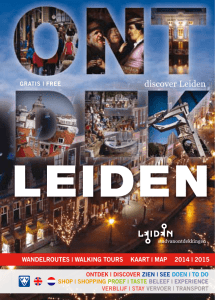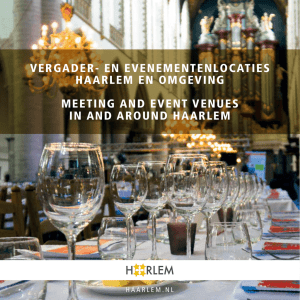
Openingstijden / Opening hours
De tentoonstelling loopt van
24.02.14 t/m 08.02.15.
The exhibition runs from
24.02.14 t/m 08.02.15.
Geopend maandag t/m vrijdag
en zondag van 11.00-17.00 uur.
Zaterdag gesloten. De entree is gratis.
Monday - Friday 11.00 a.m. - 17.00 p.m.
Sunday 11.00 a.m. - 17.00 p.m.
Closed on Saturday. Entry free of charge
Voor afwijkende openingstijden kijk op
www.wurth.nl/kunstlocatie
For different opening hours check our
website www.wurth.nl/kunstlocatie
Adres / AddressBedrijvenpark De
Brand
Het Sterrenbeeld 35
5215 MK ‘s-Hertogenbosch
Telefoon (073) 629 19 11
Telefax (073) 629 19 55
Routebeschrijving /
Route description
Openbaar vervoer:
Treintaxi vanaf CS station ’s-Hertogenbosch. Buslijn 156, halte Dungense Brug
(tijdens spitsuren halte De Brand).
Public transport:
Train taxi from Central station
’s-Hertogenbosch. Bus 156, stop Dungense
Brug (during rush hour stop De Brand)
Eigen vervoer:
Vanaf de A2 neemt u afslag Veghel
daarna industrieterrein De Brand.
Own transport:
From the A2 take exit Veghel the
business park De Brand.
Voorzijde / Cover
‘Ich zeichne immer, auch wenn ich nicht zeichne,
weil ich gerade schreibe oder konzentriert nichts tue.’
('I am always drawing, even if I am not drawing because
I am writing or intently doing nothing.')
Günter Grass, 1979
▼
Eindhoven
Veghel
▼
▼
In 2013, Lucas De Man, artistic director of Stichting
Nieuwe Helden (New Heroes Foundation) and
theatre director at Het Zuidelijk Toneel, was given the
honorary title of 'Artist in residence of the City of
's-Hertogenbosch’. De Man produces art projects and
urban actions for public spaces, in which connection
and encounter are key features. In the next four years,
De Man will be creating two urban projects with and
in the city. At the end of September 2014, OOG Den
Bosch will premiere, and occupy a visually prominent
position in the city for forty days.
Günter grass
In 'My Century' (Mein Jahrhundert), the German
writer and artist Günter Grass (Danzig, 1927) depicts
ninety-nine impressive events and minor incidents of
the twentieth century year by year. The "My Century"
exhibition reveals a lesser known side of Günter Grass,
namely as a painter.
‘s-Hertogenbosch
i.C.W. stichting nieuwe helden
100 watercolours from
from the würth collection
Amsterdam / Utrecht
OOG DEN BOSCH
24 february 2014 - 8 february 2015 inclusive
mein jahrhundert
Günter Grass
Mein Jahrhundert 1969, 1997-1999
Aquarel op papier
41,8 x 64,7 cm,
[Verzameling Würth, inv. 7689]
Günter Grass,
Mein Jahrhundert 1969, 1997-1999
Watercolour on paper
41,8 x 64,7 cm,
[Collection Würth, inv. 7689]
▼
MPR-VV-H-17’-01/’14- © By Günter Grass + Steidl Verlag, Göttingen 1999-Reproductie zonder toestemming verboden - © [2014] - All rights reserved
Contact / Contact
Drs. Brigitte Hoppenbrouwers,
Museumleiding Kunstlocatie Würth
T +31 (0)73 629 15 52
E-mail: brigitte.hoppenbrouwers@wurth.nl
Internet: www.wurth.nl/kunstlocatie
OOGINOOG
mijn eeuw-mijn stad
THE CITY project
Despite his literary success, his pictorial work does
not have to take a back seat here. It is a combination
of two media, a dialogue between word and picture.
An example of this is the illustrated book Mein Jahrhundert. According to Grass, the entire work is a German
topography, where the victims and perpetrators were
his main focus, and the event was of lesser importance.
He wrote the book from different positions, younger
and older people, men and women, etc. However, the
watercolours clearly show a catalogue of events that
include innovative, sporting and tragic occurrences
placed in a historic context of the twentieth century.
Besides drawings and sculptures, the Würth collection
also contains these original 'yearbooks’.
Günter Grass
Mein Jahrhundert 1959,
1997-1999
Aquarel op papier,
41,8 x 64,7 cm
[Verzameling Würth,
inv. 7679]
Günter Grass
Mein Jahrhundert 1959,
1997-1999
Watercolour on paper,
41,8 x 64,7 cm
[Collection Würth,
inv. 7679]
‘Erinnern heißt auswählen.’
(Remembering means selecting)
Günter Grass
With the support of his parents, he trained as
a stonemason. From 1948 to 1952, he studied
Painting & Sculpture at the Düsseldorf Art Academy.
He continued this training from 1953 to 1956 at the
School of Visual Arts in Berlin.
‘Was bleibt zu sagen: […] dass die Bildhauerei mich
gelehrt hat, stehend zu arbeiten, die Dinge von allen
Seiten zu sehen, sie fasslich, ertastbar zu machen und sie
in Räume zu stellen, auf dass sie allseits sichtbar werden.’
("What else remains to be said: [...] that sculpture taught
me to work standing up, to see things from all sides,
to make them comprehensible, tactile, and set them in
spaces where they could be viewed from all around.")
Günter Grass
Since the 'fifties', Grass has regularly combined his
talent for writing with visual art. In the famous novel
Die Blechtrommel (The Tin Drum) (1959) for the first
time he combined historic events with his surrealistic
imagery.
In the 'sixties he became a member of the Sozialdemokratische Partei Deutschlands (SPD) of Social
Democrat Chancellor Willy Brandt. On a number of
occasions, Grass took part in German and international
debates.
He received several awards for his work, including the
Nobel Prize for Literature in 1999.
OOG Den Bosch explores 'living together' (the Dutch
word for society, samenleven, is a compound of the
words living and together) and was conceived as a
response to the crumbling social cohesion caused by an
increasing anonymity of public space. De Man sees this
anonymity as the greatest threat to our society. Inspired
by the ideas of Plato, the artist tries to reveal the soul of
the city through this art project, by getting its residents
to look themselves and other people in the eye.
The urban project OOG Den Bosch consists of seven
eyes, which are individually attached to buildings and
the program Research into Society. In the seven eyes, De
Man is looking for the invisible soul stories behind the
eyes of city dwellers and in Research into Society, he asks
groups, organizations and businesses in the city to show
themselves in the city, and share. their vision of living in
society.Together the components combine into the Eye
of Den Bosch.
The exhibition OOG IN OOG – Mijn eeuw, mijn stad (EYE TO
EYE, My century, my city) - came about through a collaboration
between Kunstlocatie Würth ‘s-Hertogenbosch and Stichting Nieuwe
Helden. More than one hundred watercolours by Günter Grass in the
Würth collection will be exhibited in conjunction with the exhibition
OOG Den Bosch, an art project by the city's artist in residence Lucas
De Man. Both exhibitions show "the contemplative side" of human beings,
as individuals and as society.
The Würth Collection
The art collection of which were laid by Reinhold Würth in the 1960s, today
comprises approximately over 16.000 works of art. The collection belongs
to one of the major company collections in Europe. It mainly focuses on
painting, graphic art and sculptures created in the time between the end of
the 19th century and the present time. The art pieces are exhibited in own
museums and art dependences, free accessible to a wide audience.
The 15 art dependences and museums are located in the following countries:
Germany, Switzerland, Austria, Denmark, Norway, Belgium, Italy, Spain, France
and the Netherlands. Kunstlocatie Würth was opened in 2002 at the new
premises from Würth Nederland B.V.
’A city where people do not live together has no soul.'
Lucas De Man
The seven eyes are the eye-catchers of the urban project. They hang from several buildings in the city. They
are autonomous art installations in which visitors can
sit, hanging from a building. De Man, together with
scenery designer Pascal Leboucq, creates an urban
scenography, which explores the existential connection
of an individual with him or herself, and his or her city.
In the installation of the eye, visitors are also invited to
see the city through the eyes of 'others'. The installation offers seven audiovisual stories created in collaboration with (inter)national artists. After this experience,
visitors are challenged to look themselves in the eyes
and reveal their own story.
The Eye of Den Bosch
The city project OOG Den Bosch works up to The
Eye of Den Bosch. To do this, De Man is asking 10,000
residents and organizations from ‘s-Hertogenbosch
what one would see if one could look through their
eyes into the city's soul. These stories and eyes will
create The Eye of Den Bosch, which will be revealed on the last day of the entire project and will then
remain in the city, while the seven eye installations take
up residence.
Würth will be showing the development process
of this unusual installation in which scenographic,
theatrical, videographic and interactive techniques
combine in an exhibition that develops during the year.
For more information about OOG Den Bosch, see
www.oogdenbosch.nl
OOGINOOG
mijn eeuw-mijn stad
100 aquarellen van
Günter grass
mein jahrhundert
uit de verzameling würth
het stadsproject
OOG DEN BOSCH
i.s.m. stichting nieuwe helden
OOGINOOG
mijn eeuw-mijn stad
Met steun van zijn ouders genoot hij een opleiding tot
steenhouwer. Daarna studeerde hij van 1948 tot 1952
Tekenen & Beeldhouwen aan de Kunstacademie van
Düsseldorf. Deze opleiding zette hij van 1953 tot 1956
voort aan de Hogeschool voor Beeldende Kunsten in
Berlijn.
24 Februari 2014 t/m 8 februari 2015
‘Was bleibt zu sagen: […] dass die Bildhauerei mich
gelehrt hat, stehend zu arbeiten, die Dinge von allen
Seiten zu sehen, sie fasslich, ertastbar zu machen und sie
in Räume zu stellen, auf dass sie allseits sichtbar werden.’
Günter Grass
100 aquarellen van
Günter grass
mein jahrhundert
uit de verzameling würth
De Duitse schrijver en beeldend kunstenaar Günter
Grass (Danzig, 1927) laat met ‘Mijn eeuw’ (Mein Jahrhundert) negenennegentig indrukwekkende gebeurtenissen en kleine incidenten van de twintigste eeuw zien
per jaar. De tentoonstelling ‘Mijn eeuw‘ toont een minder
bekende kant van Günter Grass, namelijk als schilder.
‘Ich zeichne immer, auch wenn ich nicht zeichne,
weil ich gerade schreibe oder konzentriert nichts tue.’
Günter Grass, 1979
Ondanks zijn literaire succes doet zijn picturale werk
hier niet voor onder. Het is een samenvoeging van
twee media, van een dialoog tussen woord en beeld.
Een voorbeeld hiervan is het geïllustreerde boek Mein
Jahrhundert. Volgens Grass is het geheel ook een Duitse topografie, waarin de slachtoffers en daders in zijn
boek op de voorgrond stonden en de gebeurtenis van
minder belang was. Hij schreef het boek vanuit verschillende posities, jongere en oudere personen, mannen en
vrouwen etc. De aquarellen tonen echter duidelijk een
opsomming van onder andere innovatieve, sportieve
en tragische gebeurtenissen geplaatst in een historische
context van de twintigste eeuw. De verzameling Würth
bevat naast tekeningen en sculpturen van Grass ook
deze originele ‘jaarbladen’.
onzichtbare zielsverhalen achter de ogen van stadsbewoners en in het Onderzoek Naar Samenleven vraagt
hij groepen, organisaties en bedrijven in de stad zich te
laten zien en ook hun visie op samen-leven te delen.
Samen werken de onderdelen toe naar Het Oog van
Den Bosch.
‘Erinnern heißt Auswählen.’
Günter Grass
Günter Grass
Mein Jahrhundert 1969,
1997-1999
Aquarel op papier,
41,8 x 64,7 cm
[Verzameling Würth,
inv. 7689]
Günter Grass
Mein Jahrhundert 1969,
1997-1999
Watercolour on paper,
41,8 x 64,7 cm
[Collection Würth,
inv. 7689]
Sinds de jaren vijftig combineert Grass met enige regelmaat zijn talent voor schrijven met beeldende kunst. In
de befaamde roman Die Blechtrommel (1959) verwerkte hij voor de eerste keer historische gebeurtenissen
met zijn surrealistische beeldspraak.
In de jaren zestig werd hij lid van de Sozialdemokratische Partei Deutschlands (SPD) van de sociaaldemocratische bondskanselier Willy Brandt. Grass nam bij
verschillende gelegenheden deel aan Duitse en internationale debatten.
Hij ontving verscheidene prijzen voor zijn oeuvre,
waaronder in 1999 de Nobelprijs voor Literatuur.
’Een stad waarin mensen niet samen-leven,
heeft geen ziel.'
Lucas De Man
Maquette OOG
Eerste proefbouw
Hout (berken 3 mm),
75 x 45 x 50 cm
Model OOG
First test construction
Wood (birch 3 mm),
75 x 45 x 50 cm
het stadsproject
OOG DEN BOSCH
i.s.m. stichting nieuwe helden
In 2013 kreeg Lucas De Man, artistiek leider van Stichting
Nieuwe Helden en regisseur bij Het Zuidelijk Toneel,
de eretitel ‘Stadskunstenaar van de gemeente ’s-Hertogenbosch’. De Man maakt kunstprojecten en urban
actions voor publieke ruimten, waarin verbinding en
ontmoeting centraal staan. De komende vier jaar
creëert De Man met en in de stad twee stadsprojecten.
Eind september 2014 zal OOG Den Bosch in première
gaan, waar het gedurende veertig dagen een duidelijk
zichtbaar beeld in de stad zal innemen.
OOG Den Bosch onderzoekt ’samen-leven’ en is
bedacht als reactie op de afbrokkelende sociale cohesie
die een oprukkende anonimiteit van de publieke ruimte
veroorzaakt. De Man ziet deze anonimiteit als grootste
bedreiging van onze samenleving. Geïnspireerd op het
gedachtegoed van Plato tracht de kunstenaar met dit
kunstproject de ziel van de stad bloot te leggen door
bewoners zichzelf en de ander in de ogen te (laten)
kijken.
Het stadsproject OOG Den Bosch bestaat uit zeven
ogen, die afzonderlijk van elkaar aan gebouwen zijn
bevestigd en het programma Onderzoek Naar Samenleven (O.N.S). In de zeven ogen zoekt De Man naar de
De zeven ogen zijn de eyecatchers van het stadsproject. Ze hangen aan verschillende gebouwen in
de stad. Het zijn autonome kunstinstallaties waarin
bezoekers kunnen zitten, hangend aan een gebouw. De
Man creëert samen met scenograaf Pascal Leboucq
een stedelijke scenografie, die de existentiële verbinding van een individu met zichzelf en zijn of haar stad
onderzoekt. In de installatie van het oog wordt de
bezoeker ook uitgenodigd om de stad door de ogen
van ’de ander’ te zien. De installatie biedt zeven
audiovisuele verhalen gemaakt in samenwerking met
(inter)nationale kunstenaars. Na deze ervaring wordt
de bezoeker uitgedaagd zichzelf in de ogen te kijken
en zijn of haar eigen verhaal te (laten) zien.
Het Oog van Den Bosch
Het stadsproject OOG Den Bosch werkt toe naar Het
oog van Den Bosch. Hiervoor vraagt De Man 10.000
Bosschenaren en organisaties uit ’s-Hertogenbosch
naar wat men zou zien als men door hun ogen in de
De tentoonstelling OOG IN OOG – Mijn eeuw, mijn stad - is
tot stand gekomen door een samenwerking tussen Kunstlocatie Würth
‘s-Hertogenbosch en Stichting Nieuwe Helden. Ruim honderd aquarellen van Günter Grass uit de verzameling Würth worden tentoongesteld
in combinatie met de expositie OOG Den Bosch, een kunstproject
van stadskunstenaar Lucas De Man. Beide tentoonstellingen laten ‘het
beschouwende’ van de mens zien, als individu en als samenleving
Activiteiten bij Kunstlocatie Würth
De verzameling Würth
De verzameling Würth is ontstaan in de 60-er jaren op initiatief van Prof. dr.
h.c. mult. Reinhold Würth en concentreert zich op kunst vanaf het einde van
de 19de-eeuw tot en met heden. Met meer dan 16.000 schilderijen, beeldhouwwerken en grafiek behoort de verzameling tot één van de belangrijkste
bedrijfsverzamelingen in Europa. De werken worden tentoongesteld in eigen
musea en kunst-dependances, die vrij toegankelijk zijn voor het brede publiek.
De 15 kunstdependances en musea zijn gevestigd in de volgende landen:
Duitsland, Zwitserland, Oostenrijk, Denemarken, Noorwegen, België, Italië,
Spanje, Frankrijk en Nederland. Kunstlocatie Würth opende in 2002 haar
deuren in het nieuwe bedrijfspand van Würth Nederland B.V.
ziel zou mogen kijken. Met deze verhalen en ogen
wordt Het Oog van Den Bosch gecreëerd, dat op de
laatste dag van het totale project wordt onthuld en
daarna achterblijft in de stad, terwijl de zeven ooginstallaties de wereld intrekken.
Foto eerste
proefbouw OOG,
oktober 2013
Würth toont het ontwikkelingsproces van deze bijzondere installatie waarin scenografische, theatrale,
videografische en interactieve technieken samenkomen in een tentoonstelling die zich gedurende het
jaar ontwikkelt.
Photo first
test construction
OOG, October 2013
Voor meer informatie over OOG Den Bosch zie
www.oogdenbosch.nl
Rondleiding
Bij elke tentoonstelling is het mogelijk een rondleiding
te boeken. Aan elke rondleiding kunnen maximaal 15
personen deelnemen, meerdere rondleidingen tegelijk zijn
mogelijk. Een rondleiding duurt 45 minuten en kost € 40,per groep. Op aanvraag is ons auditorium beschikbaar,
hier kunnen groepen met een maximale grootte van 80
personen terecht. Zowel de rondleiding als auditoria
dienen minimaal 14 werkdagen van tevoren te worden
gereserveerd.
Würth Kinderatelier
Speciaal voor kinderen van 7 t/m 12 jaar oud wordt een
aantal keer per tentoonstelling het Würth Kinderatelier
georganiseerd. Elk kinderatelier daagt kinderen op een
toegankelijke en prikkelende manier uit een creatieve
vertaalslag van de tentoonstelling te maken. Naast een
workshop wordt er altijd een, kindvriendelijke, rondleiding
door de tentoonstelling gegeven. Per deelnemer vragen
wij € 7,50 entree voor het Würth kinderatelier.
Onderwijs
In het verlengde van elke tentoonstelling wordt een
educatief programma ontwikkeld voor het basisonderwijs.
Dit programma bestaat uit een rondleiding en een
creatieve workshop en duurt 1 uur. De begeleiding is
professioneel geschoold mét ervaring in het onderwijs.
Hierdoor zijn wij tevens in staat het programma aan te
passen aan de verschillende leeftijden en niveaus of
een totaal op maat gemaakt programma te ontwikkelen.
Tevens worden er rondleidingen gegeven aan middelbare
scholieren. Folders en kijkwijzers zijn op te vragen via
e-mail brigitte.hoppenbrouwers@wurth.nl. Alle activiteiten
voor het onderwijs biedt Kunstlocatie Würth gratis aan.
Prijswijzigingen onder voorbehoud.
Alle activiteiten van Kunstlocatie Würth zijn
projecten van Würth Nederland B.V.



